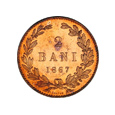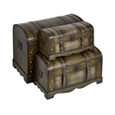Cavalry Officer (Roșior), by Ștefan Luchian
Text&photo: Sorina Gheorghiță, Romeo Gheorghiță
The painting Cavalry Officer (Roșior), oil on canvas, is signed in black color, on the lower left side: “Lukian”, without being dated by the author. The painting is in the NMRH collection with the inventory number 126105. Its sizes are: 43 x 61cm. This signature was sometimes used by the artist, especially for the works made and experimented in various graphic techniques, monochrome, pastel or watercolor. It can be found on some works created after the painter’s return from Paris, where he studied at the Julian Academy with professor W. Bouguereau. At the same time, Stefan Luchian was attracted to the impressionist experience, to the new ways in which artists like Eduard Manet, Courbet or Van Gogh used composition and color in painting.
In this work, the artist presents a soldier in a military uniform of Roșior. The cavalry officer is depicted from one side, mounted on a white horse, with a rifle on his shoulder and a sword. Through its technique, the painting seems to be a sketch, although it does not precede a larger work. The harmony and chromatic contrasts of the painting are achieved by alternating tones of green, brown, ochre, applied at the same time in paint brush overlays, opposed to the tones of blue and colored grays with hints of green. The effects of light and shade were made by gradually overlaying brighter or clearer tones.
The painting suffered previous interventions for the consolidation of the support, and some excessive cleaning operations caused abrasions on the painted surface.
The painting technique
The auxiliary support – the wooden stretcher – was correctly made, with a slope towards the inside and mobile joints, but, as time passed, it got deteriorated. The painting support is made of linen canvas, with a thin thread and thick weaving. Subsequently, this canvas was glued to a thin cardboard, by means of an animal adhesive (glue). The preparation of the canvas is also based on glue, mixed with a white-ochre paint that contains white lead as well, according to the XRF analysis. Before stretching the canvas on the stretcher, this primer was applied in a very thin layer, which allows the structure of the canvas to be seen.
The painting was made with a lot of changes and overlays of color in the paste. It was mostly made with a brush, but on the background the palette knife was also used. Thus, the paint is very thin in some parts and locally it hardly covers the primer, but there are some impasto brushstrokes, especially those of white paint, applied with the brush.
The varnish was applied very unevenly on the surface of the painting.
CONSERVATION – RESTORATION INTERVENTIONS
The conservation state
Some of the wooden wedges used for extending the stretcher and, implicitly, the canvas support, are missing. The joints of the stretcher were damaged (deformed, eroded), so it could no longer provide a proper tension for the painting support. On the lateral edges, there were cracks and numerous traces of nails from the previous stretches of the canvas on the stretcher, and, on the back, there were other nail holes from successive framings. During the latest framing, the painting was nailed and protected on the back with a sheet of paper that got oxidized.
The support of the painting was insufficiently tensed on the stretcher and it was deformed. As time passed, both the canvas support and the thin cardboard on the back got fragile due to the oxidation of the materials. Therefore, some of the numerous blows that the painting suffered caused several tears, most of which affected both layers. There are 4 (four) relatively recent small tears of the canvas in the upper part and at the base. In the lower right side, there is an older, bigger, irregular tear, which was consolidated together with the cardboard during a previous intervention. The adhesive used for consolidation produced deformations and, in some areas, the edges of the tear were overlaid. The canvas support had many other deformations caused by blows or scratches, mainly from the front to the back.
The stretching edges of the canvas were short and did not cover the entire thickness of the stretcher. They are fragile, locally unwound, with very many nail holes and tears. The adherence between the cardboard and the thin canvas was uneven, leading to deformations caused by the concentrated glue. The cardboard on the back of the canvas had a few tears and was also oxidized. It was covered in dust and stained by water and various adhesives.
The paint layer showed detachments and losses caused by blows, more extended in the areas where the canvas support was torn. There were tendencies to detachment and small lacunae all around the painting, due to the contact with the frame.
The color layer displays extended erosions, which resulted from excessive inappropriate cleaning operations carried out during some past interventions. They are located mainly on the area of the sky, on the vegetation and soil on the right side, on the character’s head and sleeve and on the horse’s mane and legs. These aggressive cleaning operations in some areas also affected the preparation, reaching, on small surfaces, up to the canvas support. Moreover, on the impasto brushstrokes the color has crackles and fissures up to the primer, with tendencies to detachment and losses.
The author signed the painting after the complete drying of the paint layer and this is the reason why it has many erosions due to previous cleaning operations. Because of this previous cleaning, the applied varnish has been partially preserved and only in small areas. This varnish preserved on the surface was photo-chemically degraded, covered in dust and insect residues. Many deposits of this kind were directly attached to the paint layer, in the areas where the varnish was missing, thus changing the chromatic rapports of the painting.
Investigations - XRF analyses
Sample 1. – the white paint on the sky contains: white lead (Pb)
Sample 2. – the red color on the serviceman’s uniform: cinnabar with a little barium sulfate (Ba). White lead (Pb) in the preparation or in the mixture.
Sample 3. – red-brown (down, near the horse’s leg): Iron oxide (Fe), with a little yellow cadmium (Cd). White lead (Pb) in the preparation or in the mixture.
Sample 4. – green (background, down, near the horse’s leg): Possibly synthetic ultramarine with a little yellow cadmium (Cd). White lead (Pb) in the preparation or in the mixture.
The carried out conservation-restoration interventions
- Local consolidations of the paint layer detachments and the temporary fixing of the tears in the support were necessary in order to allow the continuation of the intervention.
- The cleaning operations were carried out in several stages, differentiated according to the layers that make up the painting or depending on the deposits that had to be removed. Thus, the non-adherent dust deposits on the surface of the painting, as well as on its backside, were cleaned during the first stage. Solubilizing and removing the degraded varnish residues on some areas were followed by cleaning the deposits on the color layer and, locally, in the erosions of the preparation. The very adherent insect deposits were mechanically removed, with a scalpel. The tests carried out before the cleaning operations revealed the combination of painting techniques; locally, there are areas painted in tempera, next to surfaces painted in oil.
- Because of its oxidation, tears and detachments, the cardboard on the back of the canvas was removed. This operation was followed by the cleaning through mixed methods of the adhesive residues on the back of the painting. This operation was carried out mostly mechanically, with minimum moisturizing for removing the adhesive.
- After this operation, it was possible to remove the deformations of the canvas that served as a support to the painting.
- The next operation was the consolidation of the tears and the completion of the lacunae on the canvas. It has been noticed that, though thin, the canvas support has a sufficiently good mechanical resistance, so it is not necessary to line it at present. Thus, it was necessary only to consolidate the edges of the canvas by lining them with a thin linen cloth, compatible with the original support.
- It was necessary to re-stretch the canvas support of the painting on a new wooden stretcher (an auxiliary support), with mobile joints. It was noticed that some joints of the old stretcher were cut on the interior in an angle of 450, or even broken, and could no longer stretch the canvas appropriately.
- The general varnishing of the painted surface was followed by the completion of the lacunae with putty, for bringing them to the same level as the original painted surface around them. At the same time, it was aimed at restoring the original surface structure: brushwork, primer surface, canvas weaving, etc.
- The puttied lacunae and the color layer erosions were chromatically reintegrated by means of reversible and stable water- or solvent-based paints.
- At the end of the restoration operations, a new varnish layer was applied by spraying, for protecting the painted layer and for homogenizing the shine of the surface.
- The backside of the painting was protected by applying, in a reversible system, a rigid cardboard, with a neuter PH.
- The correct framing and protection of the painting perimeter aimed at avoiding abrasions at the contact with the frame, by applying some strips of felt on the inside.

















